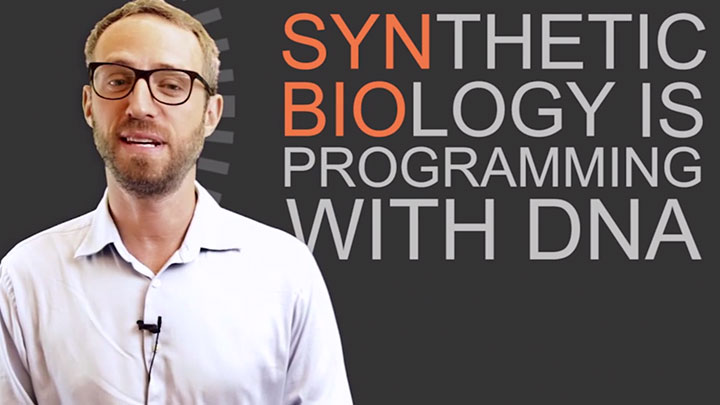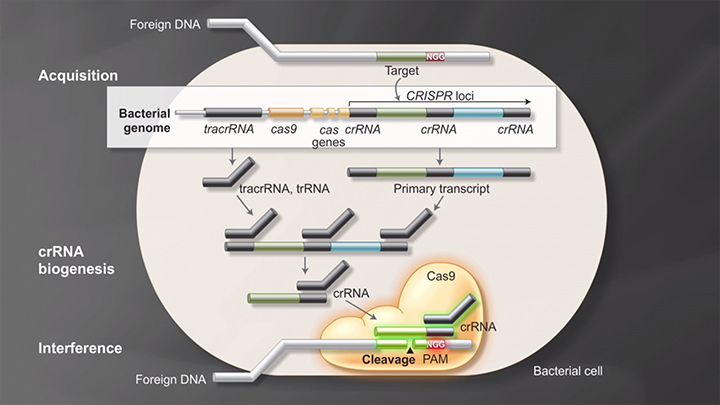NEB® TV Ep. 7 – Synthetic Biology/ CRISPR
Script
NEB TV, what's trending in science.
Deana Martin:
Welcome to NEB TV. Today I'm joined by Breton Hornblower, one of our product marketing managers. Hey, Breton.
Breton Hornblower:
Hello, Deana.
Deana Martin:
Today we are talking about synthetic biology and CRISPR/CAS9.
Breton Hornblower:
Great, so first what we're going to do is I'm going to give you a 60 second run through on the basics of CRISPR/CAS9. Then after that, we're going to go over and visit Natalie Kuldell. She just founded BioBuilder Club, an educational initiative targeted at high school students in synthetic biology. After that, we're going to go over and visit Ron Weiss at MIT. Ron's going to give us some insights into synthetic biology, and also explain some commonly used terms.
Deana Martin:
Great. Let's get started.
Breton Hornblower:
CRISPR is an acronym that stands for Clustered Regularly Interspaced Short Palindromic Repeats. The other term that you often hear associated with CRISPR is Cas, which stands for CRISPR-Associated. CRISPR is arrays and Cas genes are essential for adaptive immunity and some bacteria and archaea. Together they enable the organisms to respond to and eliminate invading material like phage.
CRISPR-Cas systems are diverse, but all incorporate DNA corresponding to genetic material of invaders as spacers in repetitive arrays. These repetitive arrays are transcribed and processed to make guides for nucleases that target and destroy invaders.
The CRISPR system from streptococcus pyogenes, and in particular Cas9 nuclease, has been widely adopted as a tool to make site-specific double-stranded DNA breaks. This can be used in vitro, but when used in vivo and introduced into living cells, can be used for precise editing and engineering of genomes. Mutations of the nuclease have also increased its specificity in binding dependent and cleavage independent uses.
Today we're here with Natalie Kuldell. We're at LabCentral in Cambridge. Natalie is the founder of BioBuilder.org. Natalie, would you like to tell us more about BioBuilder?
Natalie Kuldell:
I would be happy to. BioBuilder came from my teaching in the Department of Biological Engineering at MIT, where I found it really effective for students to be learning engineering through design challenges and using biology to meet real world problems and issues. I have partnered with some wonderful high school teachers to make that curriculum that we teach in the department modular and amenable to the frameworks and the goals that they have as high school teachers.
BioBuilder now is available online with hands on laboratory reagents and kits, as well as a data sharing portal, so that people who are interested in bringing design and learning life science through engineering can do it in classrooms all over the country.
Breton Hornblower:
Great. Natalie also recently started BioBuilder Club.
Natalie Kuldell:
Yes.
Breton Hornblower:
Can you tell us a little bit more about that?
Natalie Kuldell:
Yeah, happy to. The success of BioBuilder in the high school classroom has been wonderful. We are excited to bring it to as broad an audience as possible. In some places, there are challenges to bringing things into the classroom. The afterschool clubs seem like a way that we could broaden the community of BioBuilders. Now we have teams all over the country, and actually all over the world, who work with their teachers, so teams of students with their teachers, outside of school time, to design, build and test novel biotechnologies that come from their own ideas and their own personal meaningful efforts.
Breton Hornblower:
Thanks so much for taking the time to speak with us today.
Natalie Kuldell:
Thanks, yup, thank you.
Ron Weiss:
Hi. My name is Ron Weiss. I'm the director of the Synthetic Biology Center at MIT. I'm also a professor in biological engineering, and in electrical engineering, computer science at MIT.
Ron Weiss:
A biological circuit is really a collection of parts that regulate one another to achieve a specific function. Basically the level of sophistication that you can encode in a biological circuit is often correlated with the size of the circuit, so the more easily we can create larger circuits, the more easily we can create sophisticated behaviors inside the cells. A major bottleneck in that is how do you assemble multiple pieces together to create a single plasmid, for example, that encodes all of these regulatory interactions between each other.
Ron Weiss:
One of the things that we really like about the technology is the fact that you can also build biological circuits out of the Cas/CRISPR technologies, meaning that you can have one component that's based on, let's say, guide RNA, which then regulates the production of another guide RNA. It can repress it or it can activate it. So by having these links between guide RNAs, you can actually create biological circuits.
Ron Weiss:
I'm very excited about the notion that we are now moving away from just building various kind of prototype circuits in synthetic biology towards circuits that may actually have certain applications, therapeutic applications, diagnostic applications, things that might be related to cancer detection in therapy, things that might be related to stem cell differentiation, organoid formation, engineering the gut microbiome for therapeutics, so really a lot of exciting applications moving synthetic biology from the lab possibly to industry in clinical applications.
Deana Martin:
Breton, thanks for joining us today.
Breton Hornblower:
Thanks for having me.
Deana Martin:
As always, if you have any suggestions for future episodes, please let us know.
Related Videos
-

NEB® TV Ep. 1 – Synthetic Biology -

Bacterial Adaptive Immunity with CRISPR/Cas9 -

Science in 60 CRISPR/Cas9

